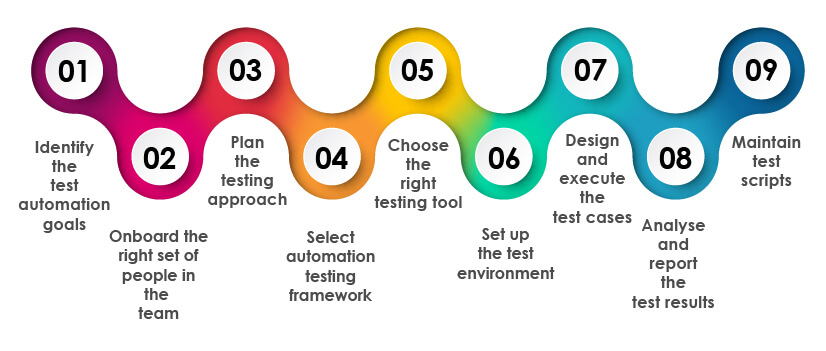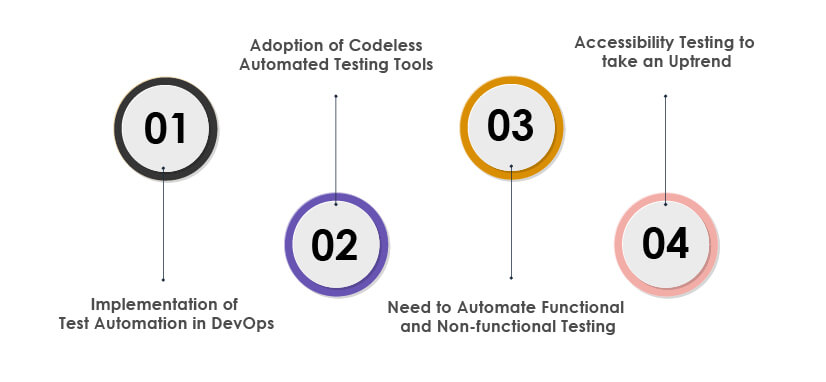
“@context”: “https://schema.org”,
“@type”: “FAQPage”,
“mainEntity”: [{
“@type”: “Question”,
“name”: “What is Automation Testing?”,
“acceptedAnswer”: {
“@type”: “Answer”,
“text”: “test Automation is an advanced software testing method in which automated tools and frameworks are used to test the software. Unlike the manual software testing method, the software test automation method needs minimal human intervention except for writing the automation scripts, and these scripts are automatically run using automation tools.”
}
},{
“@type”: “Question”,
“name”: “How to build an Effective Automation Testing Strategy?”,
“acceptedAnswer”: {
“@type”: “Answer”,
“text”: “A well-planned automation testing strategy is the key to the success of the automated software testing process, and when successfully executed, it delivers numerous benefits. Some of the benefits include increased test coverage, increased test reliability, faster time-to-market, quicker ROI. Businesses need to adopt the below-given process for an effective software test automation strategy.”
}
},{
“@type”: “Question”,
“name”: “How can TestingXperts (Tx) help?”,
“acceptedAnswer”: {
“@type”: “Answer”,
“text”: “TestingXperts (Tx) has been at the forefront of enabling test automation services for clients across industries. We have expert QA teams with rich expertise in all leading open-source and commercial automation tools.”
}
}
In the current fast-paced business landscape, staying ahead of the competition requires rolling out high-quality products quickly to the market. To achieve this, software testing plays a crucial role.
In the United Kingdom, businesses employ various types of software testing, including functional, regression, smoke, and non-functional testing. With the growing adoption of DevOps and agile practices to expedite software delivery, test automation has emerged as a leading approach, enabling businesses to achieve faster and more reliable releases.
Content
1. What is Test Automation?
2. Why is Test Automation Important?
3. Different Types of Test Automation
4. How to build an Effective Automation Testing Strategy?
5. 4 Major Automation Testing Trends to Look at in 2023
6. Conclusion
7. How can TestingXperts (Tx) help Your Business in the United Kingdom?
What is Test Automation ?
Test Automation is an advanced software testing method in which automated tools and frameworks are used to test the software. The software test automation method requires less human involvement than manual software testing. It involves writing scripts and executing them using automation tools.
It helps the QA team by reducing the effort required for repetitive tasks. Doing so, it lowers regression time and cost. This testing method fast tracks the overall software testing process and reduces the test cycle time drastically.
A dedicated QA automation test engineer plays a crucial role in software companies. These professionals design and develop test scripts during the initial phases of a project. Collaborating closely with automation testers and product developers, they ensure comprehensive testing of software and products. As part of a cohesive team, they control test automation initiatives, utilizing various automated testing frameworks and software testing automation tools to identify the most effective approach for successful test automation.
It has been noted that the software automation testing market has been rapidly growing in leaps and bounds in recent years.The global automation testing market will increase from USD 12.6 billion in 2019 to USD 28.8 billion by 2024. The compound annual growth rate (CAGR) will be 18.0% during the forecast period of 2019-2024. According to GlobeNewswire, the automation testing market is expected to reach USD 68 billion by 2025. This growth is possible by integrating IoT, DevOps, and AI technologies. It led businesses to adopt automation solutions, which increased demand for this market.
Businesses must put in place a reliable automation testing strategy. It will ensure faster releases and provide customers with a smooth experience. This will also improve product quality.
Why is Test Automation Important?
Manual testing alone can become a bottleneck with the increasing complexity of applications and the need for faster releases. This is where test automation comes in. Let’s have a look at the following benefits of automation testing:
- Accelerates the testing process and reduces time-to-market
- Enhances test coverage and quality assurance by consistently executing comprehensive tests
- Improves accuracy and reliability of test results by eliminating human error
- Optimizes costs and resources by reducing manual effort and enabling parallel execution of tests
- Facilitates continuous integration and continuous delivery (CI/CD) practices for faster and more frequent software releases
- Allows organisations to respond swiftly to market demands and gain a competitive edge
- Minimizes the risk of critical defects reaching end-users, enhancing overall software quality
Different Types of Test Automation
Automation testing encompasses various techniques and tools, each serving a specific purpose in the testing lifecycle. By leveraging the power of automation, organizations can achieve faster time to market, improved quality, and reduced costs. Let us understand various automation testing types and their applications, empowering you to make informed decisions for your testing strategy:
Unit Testing
Unit testing serves as the foundation of automation testing. It involves verifying individual units or components of software to ensure they function as intended.
Developers primarily conduct unit tests, employing frameworks like JUnit for Java or NUnit for .NET. These tests focus on isolating small portions of code, making identifying bugs or issues early in the development cycle easier. Unit testing promotes code reusability, enhances maintainability, and helps prevent regression errors
Functional Testing
Functional testing verifies whether software applications meet functional requirements and operate as expected. It examines the system’s behavior by testing its functions, features, and user interactions.
Tools like Selenium, Appium, or Cypress are commonly used for web and mobile application functional testing. Automating repetitive tests allows organizations to improve accuracy and cut effort. It results in smooth application operations
Integration Testing
Integration testing focuses on validating the interactions between different components or modules of an application. It ensures that the integrated unit’s functions harmoniously and exchanges data correctly.
Automation tools like Apache JMeter, SoapUI, or Postman are commonly employed for this type of testing. Integration testing helps identify interface issues, data transmission problems, and interoperability glitches, allowing developers to rectify them promptly.
Performance Testing
Performance testing assesses a software application’s responsiveness, stability, scalability, and resource usage under varying workload conditions.
Performance testing tools like JMeter, LoadRunner, or Gatling simulate real-life scenarios. It is to measure and analyze system behaviour. This helps organizations identify and resolve performance bottlenecks. Automated performance testing provides valuable insights into system capacities, ensuring optimal performance and user experience.
Security Testing
With the rise in cyber threats, security testing has become critical to safeguarding sensitive data and ensuring system integrity. This type of testing identifies vulnerabilities, flaws, or weaknesses in an application’s security infrastructure.
Automated security testing tools like OWASP ZAP, etc., assist in identifying security errors. Such tools also confirm encryption methods and prevent potential breaches. Automated security testing aids in maintaining data confidentiality, integrity, and availability.
Regression Testing
Regression testing validates that recent changes or modifications in software do not negatively impact existing functionalities. It helps ensure that new features or bug fixes refrain from introducing new issues or breaking previously working components.
Automated regression testing reduces errors, saves time, and ensures thorough test coverage. It also supports continuous integration and continuous delivery (CI/CD) pipelines.
How to build an Effective Automation Testing Strategy?
Having a well-planned automation testing strategy is essential. It will ensure the success of the automated software testing process. When implemented, it brings many advantages. Some of the benefits include increased test coverage, increased test reliability, faster time-to-market, quicker ROI. Businesses need to adopt the below-given process for an effective software test automation strategy.
Identify the Automation Testing Goals:
Identifying testing goals even before starting the automated QA testing process is essential as it helps keep the testing process on track. The goals can be faster test execution, improved test results, improved accuracy, reduced regression time, cost savings, etc.
Onboard the right set of people in the team:
Once the automation goals are identified, it is essential to have the right set of people in the team. The teams need practical experience to write test scripts. Then comes running tests, checking for failures, updating tests, and writing regression tests.
Plan the testing approach:
After the right team is identified and tasks aligned, it is time to plan the testing approach. It is essential first to determine what is to be automated, then select the level at which the test is to be written, and finally decide what type of test is to be executed.
Select automation testing framework:
Test automation frameworks are the guidelines that need to be followed while writing and running the tests. Based on the need, teams can choose frameworks such as Linear scripting (record and playback), Library architecture testing framework, Modular based testing framework, Data-driven testing framework, etc.
Choose the right testing tool:
It is essential to choose the right testing tool for a successful automated software testing process. Typically, to select the right testing tool, it is necessary to check its compatibility with the current project’s technology stack, language support, test environment support, browser, operating system (OS) support, mobile/desktop/web app, etc.
Set up the test environment:
Once all the above steps are accomplished, it is time to set up the test environment to execute the test. To set up the test environment, acquire the hardware and software required to run the test.
Design and execute the test cases:
This is a crucial step where test scripts are created and executed. While creating the test scripts, make sure they are reusable, well-structured, and properly documented. Once the test scripts are created, execute them using automation testing frameworks and tools.
Analyse and report the test results:
Finally, after the test execution process is completed, it is important to analyze the test results to check what went wrong, what needs to be fixed or improved, how successful the test was, etc. It is necessary to share the test outputs and findings with all the stakeholders.
Maintain test scripts:
As the last step, it is necessary to maintain the test scripts so that they can be reused for regression tests or for testing a similar kind of software. Also, keep cleaning the obsolete test cases and adding the new test cases to the repository to ensure effective automation and future reuse of the test scripts.
For a successful automation testing journey, building an effective test automation strategy and adopting the latest automation testing trends is essential for today’s businesses to stay ahead in the market.
4 Major Automation Testing Trends to Look at in 2023
Implementation of Test Automation in DevOps:
DevOps has been in practice for some time now, but the use of test automation in DevOps is said to increase significantly. According to EINPresswire, The automation testing market is expected to grow from USD 8 billion in 2018 to USD 60.4 billion by 2026, at a CAGR of 33.4% during the forecast period 2018-2026. The automation testing market growth is because of the rising demand for DevOps in automation.
Moreover, enterprises can take DevOps to an entirely new level by increasing the implementation of automated testing in DevOps and leveraging robust automated security testing services. It will enhance security and will also ensure early and continuous security testing throughout the software delivery pipeline. Some of the leading automated testing tools for DevOps and continuous testing are Test Sigma, Selenium, Appium, etc.
Adoption of Codeless Automated Testing Tools:
Increased adoption of codeless automated testing tools will be the major trend in the upcoming year. According to the Perfecto Report titled “The 2021 State of Test Automation Report,” 40% of companies are interested in using codeless solutions.
Codeless testing is a process of creating automated tests without writing a single line of code. It requires the use of codeless testing tools that are built on AI and visual modelling technology. Codeless testing techniques offer several advantages. It includes ease of use, faster test execution, optimal resource use, and more. Some of the leading codeless test automation tools are Katalon Studio, TestCraft, Perfecto, etc.
Need to Automate Functional and Non-functional Testing:
It is expected that there will be a significant increase in software test automation. It is necessary to automate functional and non-functional testing. It includes performance testing, security testing, accessibility testing, and usability testing.)
In today’s competitive landscape, businesses must deliver high-quality software to customers. Automating the software testing process is the best method to overcome this challenge. By doing so, businesses can expand test coverage and achieve faster test execution. It will also ensure high-quality products and reduce time-to-market. However, automation of the software testing process is not possible without quality automation tools. Tools like Selenium, Tricentis Tosca, etc., are good for functional tests. Tools like JMeter, Neoload, etc., are good for non-functional tests.
Accessibility Testing to take an Uptrend:
Another trend that is expected to gain momentum is the rise of accessibility testing. According to a report by GlobeNewswire, the accessibility testing market is expected to hit $606.46 million by 2027. As businesses adopt digital solutions, the demand for accessible software is also growing.
Businesses must ensure that their software is accessible to everyone. It includes individuals with disabilities like blindness, motor impairment, colour blindness, etc. Businesses should ensure their apps follow certain accessibility guidelines such as W3C’s, i.e., WCAG 2.0, WCAG 2.1, Section 508, Stanca Act, etc. Businesses can leverage various accessibility testing tools such as Dynomapper, WAVE, JAWS, etc.
Conclusion
DevOps continues to gain popularity in the United Kingdom. This is why automated software testing has become essential for businesses in the UK. This testing method will experience significant growth in the upcoming years. The integration of AI and ML technologies will go with it. Enterprises should use automation to achieve faster releases and ensure high-quality products. It will help them gain an early market presence to improve customer experience (CX). Businesses should leverage next-gen QA and independent software testing services providers for the test automation in DevOps implementation.
How can TestingXperts (Tx) help Your Business in the United Kingdom?
TestingXperts (Tx) has been at the forefront of enabling test automation services for clients across industries. We have experienced QA teams who know about open-source and paid automation tools to address the benefits of automation testing.
Tx has an in-house extensible automation framework, Tx-Automate, which is modular, reusable, and compatible and can be customized based on the business need.
Our test automation engineers have implemented RPA UiPath Test Automation for global clients. It includes Spotify, a renowned audio streaming company in Sweden and the US.
Why Choose Our Automation Testing Service?
- Expertise in various types of automation like functional testing, regression testing, performance testing, etc.
- Robust automated test framework for efficient script development, execution, and maintenance
- Comprehensive automation tests for website testing, ensuring functionality and compatibility across browsers and platforms
- Utilisation of cutting-edge test automation software for enhanced efficiency and accuracy
- End-to-end testing automation services cover the entire testing lifecycle
- Automated browser tests to validate functionality and compatibility across multiple browsers
- Emphasis on continuous test automation earning and skill enhancement
- Advantages of automation testing: reduced testing time, increased test coverage, improved accuracy, and enhanced software quality
- Support for beginner test cycles, assisting organisations in implementing automation testing smoothly
Therefore, Tx can be a one-stop solution for all your automation software testing needs. Get in touch with our automation testing experts to know more.
The post How to Build an Effective Automation Testing Strategy For Businesses first appeared on TestingXperts.













